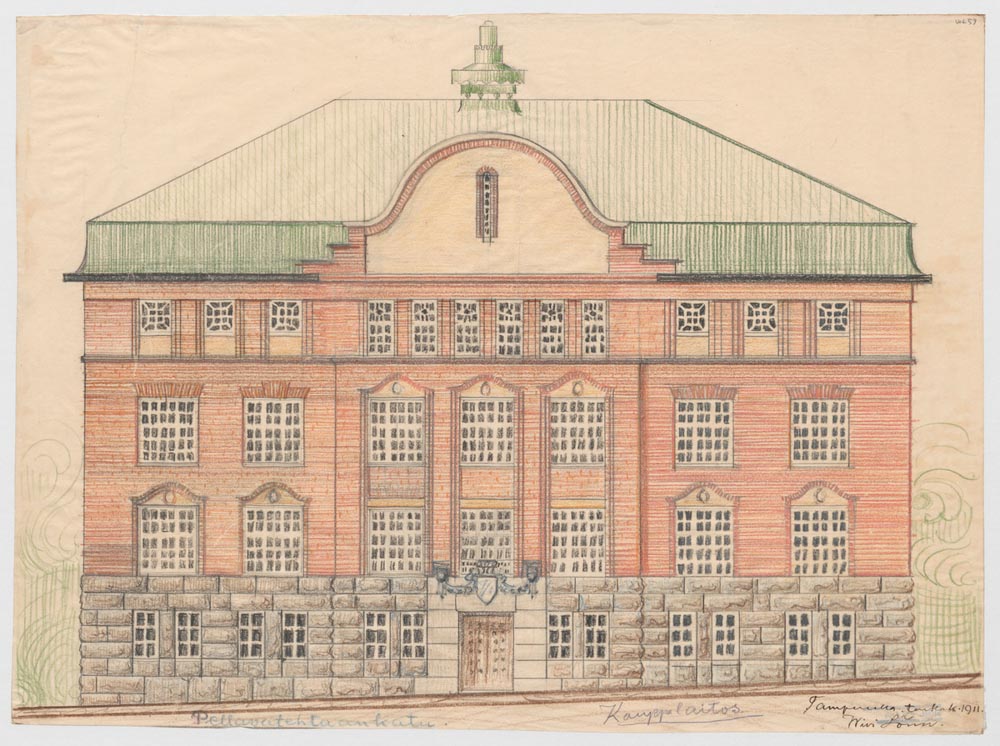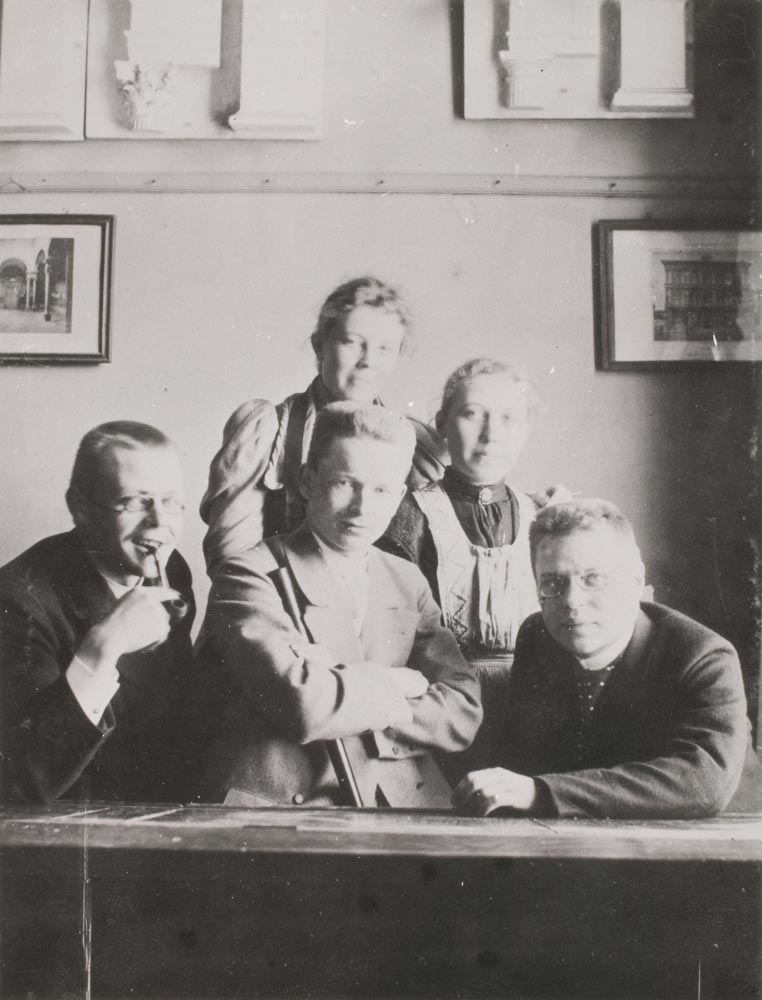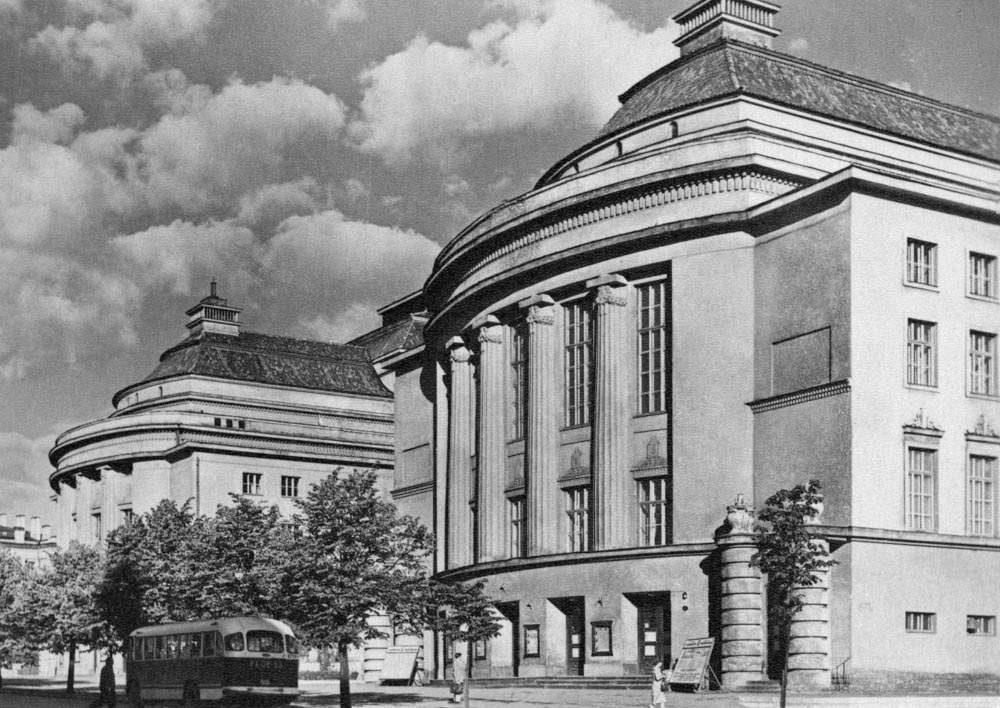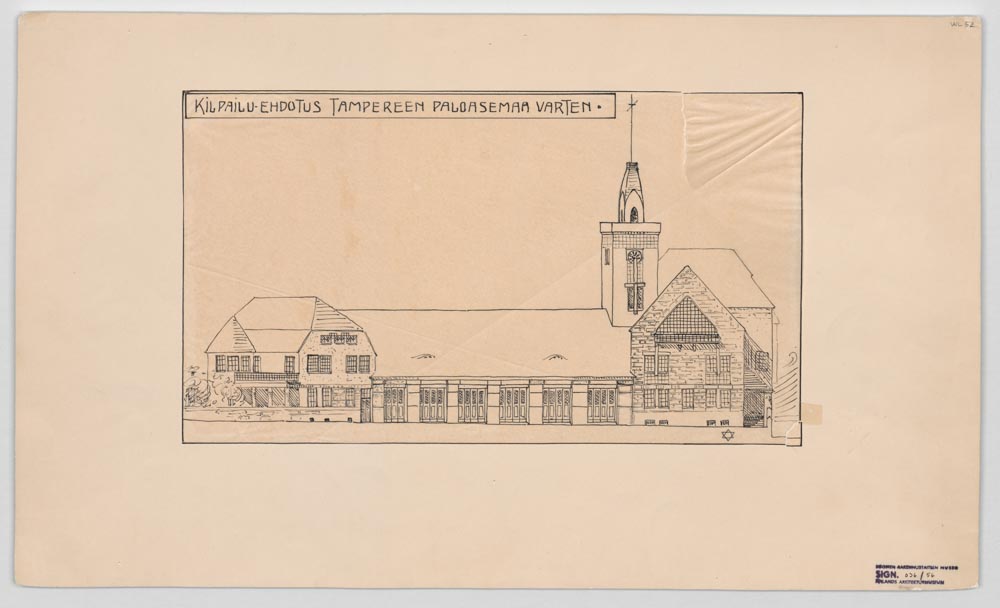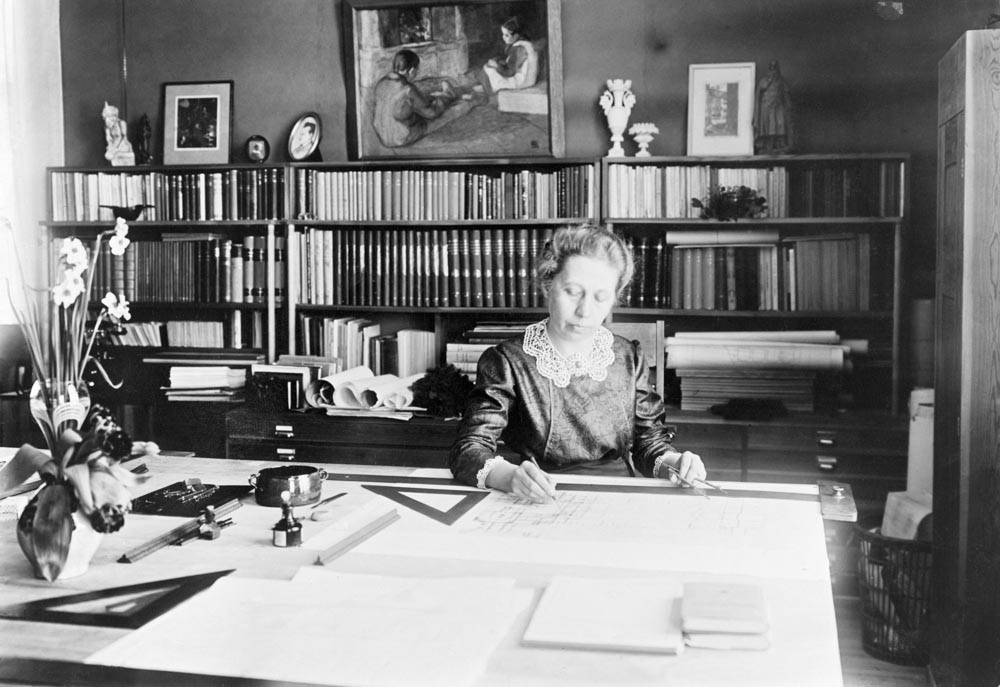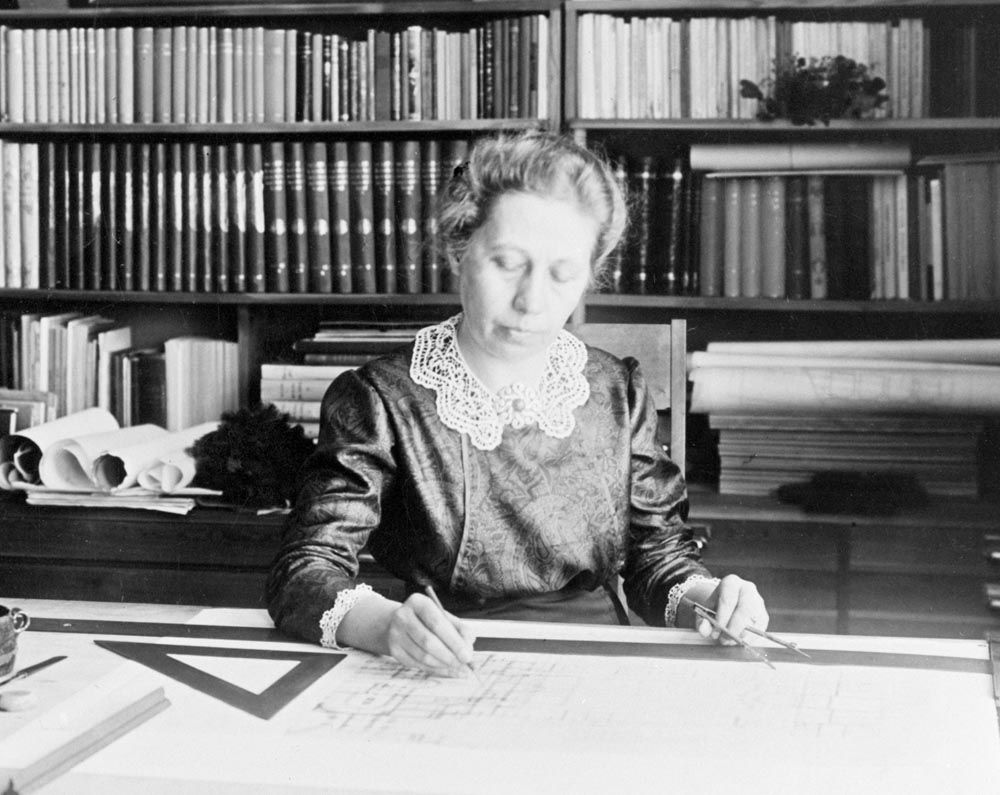
20140523 . Arkkitehti Wivi Lönn työhuoneessaan
Wivi Lönn (1872–1966) oli tuottelias arkkitehti, jonka suunnittelemia rakennuksia löytyy mm. Helsingistä, Tampereelta ja Jyväskylästä. Hän johti omaa arkkitehtitoimistoa, ensimmäisenä naisena Suomessa, ja suunnittele mm. useita koulurakennuksia. Esimerkiksi Edvin Laineen koulun puuosan hän suunnitteli Iisalmeen 1900-luvun alussa.
Olivia Mathilda Lönn syntyi Tampereella vuonna 1872. Hänen isänsä oli panimomestari Emanuel Wilhelm Lönn ja äitinsä Johanna Maria Mathilda Sirén. Olivia oli perheen toinen lapsi. Hänen isoveljensä Fredrik Wilhelm oli syntynyt 1870. Olivian jälkeen perheeseen syntyivät vielä vuonna 1874 Emil Arvid ja vuonna 1876 Aina Maria. Perhe asui Onkiniemen oluttehtaan lähistöllä tehtaan omistamassa huvilassa. Lönn muisteli viihtyisää ja kaunista lapsuudenkotiaan lämmöllä vielä vanhuuden päivillään.
Wivi Lönnin lapsuutta heijasti tragedia, hänen isänsä kuoli 1888 jonka jälkeen perhe joutui taloudelliseen ahdinkoon. Wivin yksinhuoltaja äiti joutui turvautumaan lastensa apuun hänen elättäessään perhettä täysihoitolan pitäjänä. Wiviltä kului keskikoulun valmistumiseen kuuden vuoden sijasta 8 vuotta.
Keskikoulussa Lönnillä oli erinomainen matematiikan opettaja, jonka ansiosta hän oppi laskemaan ylioppilastason matematiikkaa. Matematiikassa hän oli luokkansa paras joka johti mielenkiinnon arkkitehtuurin pariin. Keskikoulun viimeisillä luokilla Lönn oli alkanut käyttää nimestään lyhennettyä muotoa Vivi ja pian sen jälkeen muotoa Wivi. Puhuttelunimi vakiintui myöhemmin hänen arkkitehtinä käyttämäkseen nimeksi.
Wivi Lönn on ehkä aliarvostetuin suomalaisista suurista arkkitehdistä. Hän jää usein Saarisen, Engelin, Lindgren ja Sonckin varjoon, vaikka hänen teokset ovat samalla tasolla kuin edellämainittujen mestareiden rakennukset.
Wivi Lönn on tunnettu monista kouluistaan joista mainetta on kerännyt Tampereen Suomalainen tyttökoulu, Tampereen Aleksanterinkoulu, Mikkelin Suomalainen yhteiskoulu ja Tampereen kauppaoppilaitos. Jyväskylässä Lönn suunnitteli Seminaarinmäelle lähes kokonaisen kaupunginosan. Jyväskylän juomatehtaalle hän piirsi punatiilisen tehdasrakennuksen ja kivestä ja puusta rakennetun asuin- ja konttorirakennuksen.
Wivi lönnin mahtipontisin teos lienee Estonia teatteri, joka tänäkin päivänä hallitsee Tallinnan vanhan kaupungin ilmettä. Estonia teatteri oli Wivin ja Armas Lindgrenin merkkiteos Thalia vuodelta 1908. Kyseisellä suunnitelmalla he voitti monitoimi teatteri- ja oopperatalon suunnittelukilpailun. Varsinainen Estonia teatteri valmistui vuonna 1913.
Iisalmen Kauppalan ensimmäinen kansakoulurakennus valmistui 1878 tontille n:o 10 nykyisten Savonkadun ja Ilvolankadun kulmaukseen. Koulun oppilasmäärä kasvoi Iisalmen tultua kaupungiksi ja tarvittiin lisää tilaa. 1905 kaupunki osti koulutontin, naapuritontin n:o 9 Anna Sofia Korhoselta. Tontit yhdistettiin yhdeksi tonttimaaksi ja ryhdyttiin puuhaamaan uutta erillistä lisärakennusta.
Wivi Lönn suunnitteli Iisalmen Edvin Laineen koulun puuosan 1900-luvun alussa.
1908 valmistui kansakoulun uusi puoli, arkkitehti Wivi Lönnin suunnittelema puurakennus. Uusi puoli oli vanhan puolen tyylinen yksikerroksinen puurakennus, johon tuli 6 luokkahuonetta ja juhlasali. Rakennus katettiin rautapellillä. Rakennus sijoitettiin tontin nro 9 läntiseen kulmaukseen. Koulun pihamaaksi jäi molempien koulujen välinen alue.” ”Jugendtyylinen, yksityiskohdiltaan melko rikas vuosisadan alun koulurakennus ja edustaa Wivi Lönnin tuotantoa. Rakennus liittyy Iisalmen koululaitoksen historiaan. Rakennus sijaitsee kaupunkikuvallisesti merkittävällä paikalla Kirkkoaukion reunalla.
Museum Agency
Wivi Lönn oli aktiivinen 30-luvulle saakka mutta arkkitehtuurin vallitsevan trendin muuttuminen 1920-luvun klassismista funktionalismiin, tyrehdytti Wivin tahdon jatkaa suunnittelua, vaikka joitain töitä valmistui niinkin myöhään kuin 50-luvulla. Wivi Lönn totesi että rakennusmateriaalit ja uudet suuntaukset ovat ajaneet hänen aikansa ohi. Wivi Lönn kuoli 94 vuoden iässä. Hän asui viimeiset vuodet Helsingissä itse suunnittelemassaan “Hotelli Helkan” talossa. Talon oli rahoittanut Wivin pitkäaikainen ystävätär kauppaneuvos Hanna Parviainen, Hannalla oli niin ikään asunto samassa talossa.
Wivi is buried in the Kalevankanka cemetery of his hometown, Tampere.
Sources:
General catalog of Finnish building culture.
Holmila, P. 2022. Arkkitehti Wivi Lönn oli ehkä merkittävämpi nimi 1900-luvun arkkitehtuurissa kuin on edes tajuttu. HS.fi 29.4. https://www.hs.fi/kulttuuri/art-2000008775566.html
Kuvat: Helsingin kaupunginmuseo. Museoviraston historian kuvakokoelma. Lönn, W. & Lindgren, A. Estonia -teatteri, Tallinna, Arkkitehtuurimuseo.
Luonnokset: Lönn, W., Tampereen kauppaoppilaitos, Arkkitehtuurimuseo.

